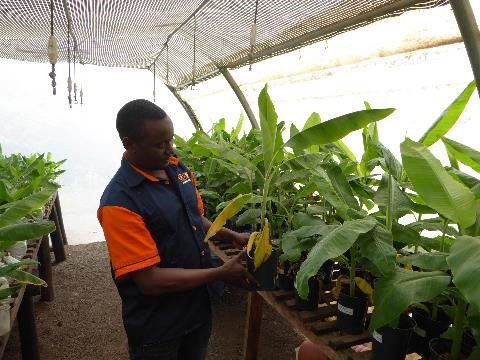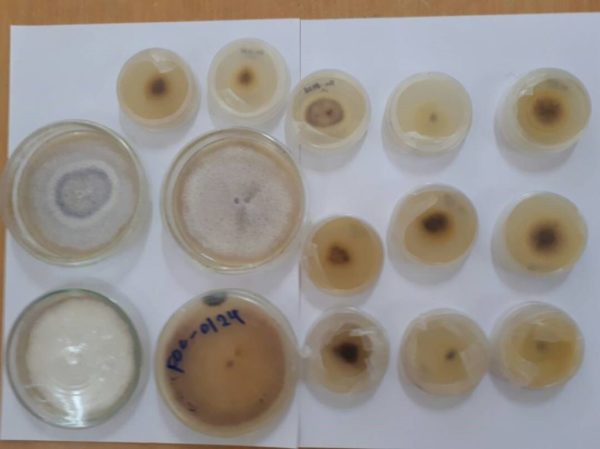Hi pests and diseases, it’s your nasty cousin Fusarium. I’ve got an update for you from banana fields and scientists’ labs in Arusha, Tanzania. Its rather mixed news, I am afraid, as the humans seem to be making some progress.
First, some good news. Coffee prices and profits are down so many farmers are interested to switch to bananas. That could mean a bigger area to attack. And once I can get into the soil in their fields, I can stay for at least sixty years. Isn’t it great?
Fortunately, most farmers still aren’t aware that I am spreading in their irrigation water and even on their pruning tools. And climate change seems to be giving me a helping hand, because farmers are irrigating more since it has been so dry. I’m on the move, and you don’t have to take my word for it. According to Akida Meya, of The Nelson Mandela African Institution of Science and Technology (NM-AIST). “Since last year Fusarium wilt is making a breakthrough in higher lands on Mount Meru above 1,200 meters where it hadn’t gotten a foothold before.”
I’m really making progress in Arusha, where I’m knocking out the Mchare banana variety, which humans in the East African highlands like for cooking with meat in stews and other dishes. One real sign of my success is that Mchare is getting scarcer and more expensive in local markets. Isn’t that a fabulous indicator of my progress?
Look at this photo below of a farmer’s field of Mchare that I just about wiped out; and I did it right under the scientists’ noses, near the Tanzanian Coffee Research Institute (TaCRI)! That farmer won’t harvest anything from those plants.

Mzee Mbora Ulotu, who works with the team at TaCRI, practices traditional and now disappearing coffee-banana intercrop on his own farm
It’s not all good news though. Some of the farmers have been tipped off by the scientists and extension people. Mzee Ramadhan Rashid Kimaro of Masama village is one of this dangerous group. He realized that I was attacking his Mchare bananas and changed tactics. Four years ago, with help from those pesky scientists at the Ministry of Agriculture Training Institute in Horti-Tengeru, he got new plants from tissue culture including Paz, Grand Naine and Williams (dessert bananas also used for cooking). Thanks to those new varieties, careful residue management, manure and managing sucker replacement to keep his banana plants nicely in rows, he is getting very good bunches and making money from bananas. All quite upsetting for me, although luckily more than 85% of farmers haven’t caught on. Fortunately, there isn’t any network of community level nurseries where farmers can get clean planting materials of resistant varieties, although a few have gone to Crop Biosciences in Arusha or Kilimorgano in Dar es Salaam. So far there aren’t any resistant varieties of Mchare, so I am going to continue to feast on those.
There is a rather troublesome group of scientists from the International Institute of Tropical Agriculture (IITA) working with NM-AIST that has me worried. They’ve got some great shared labs and a rather impressive group of scientists who have me in their sights. They are trying to nail me down with an excellent tissue culture, molecular and pathology facility which speeds up their access to plants for experiments and eventually new varieties.
Worse yet, IITA and Bioversity International have teamed up in a new project called ‘Improvement of banana for smallholder farmers in the Great Lakes Region of Africa,’’ under the logo “Breeding Better Bananas – BBB,” which is supported by the Bill and Melinda Gates Foundation. It’s part of the CGIAR Research Program on Roots Tubers and Bananas, which is chasing down us pests and diseases. BBB has brought in 21 NARITA hybrids which are good for cooking, although they are Matoke rather than Mchare types. Noel Madalla and his colleagues at Bioversity International have planted these out in Moshi at TaCRI in what they call a “mother trial”. With the aid of clever software on a tablet, they are collecting massive amounts of data about me and my cousin Sigatoka (a.k.a. black leaf streak), as well as plant growth and yields. I heard Madalla say that “Next year we are going to have farmers select from the mother trial those which taste and look the best to test in their own fields in ‘baby trials’.”
I am getting worried that this BBB group may find a resistant NARITA which farmers like and the women say is good for cooking. Then I’ll be in trouble!
Banana breeders have already made crosses of Mchare varieties with wild relatives with resistance to my disease: Fusarium wilt. Fortunately, it’s going to be a challenge for them to develop resistant varieties that farmers will grow, because the humans are very fussy and like great tasting bananas. That should take them a while, or so I hope, though scientists at IITA and Horti-Tengeru are trying to speed things up. They have a mapping population made by crossing a resistant wild banana relative with a susceptible one, so they have a large number of genetically different plants, some with resistance genes, to do detective work on. They put 50 g of millet seeds infected with me, Fusarium, in each pot with a banana plant to see if I can infect the plant. Then those crafty scientists are going to collect DNA from all these plants and send them off for genotyping to BTI, in the USA, to find which nasty genes stop me from infecting banana plants. Their goal is to identify markers for Fusarium wilt resistance which the breeders can use to stop me in my tracks. Mohamed Mpina of IITA predicts that “We should have the markers in a couple of years and that will really speed up our breeding, which takes so long because we have to get back to a seedless variety after making our crosses”.

Mohamed Mpina should have markers from this mapping population at Horti-Tengeru inoculated with Fusarium wilt

Hassan Mduma’s research is throwing light on how nematodes in these pots aggravate the effects of Fusarium wilt
As you might imagine, I’m getting a little nervous, but I haven’t given up. I’m hoping climate change will lend me a hand. Nevertheless, those guys at BBB have me worried. It should take them a few more years to give me serious trouble, though, so in the meanwhile, I’ll keep up my destruction. Will send another letter to the pests and diseases family next year.
Text and photos by Graham Thiele, Director, RTB







